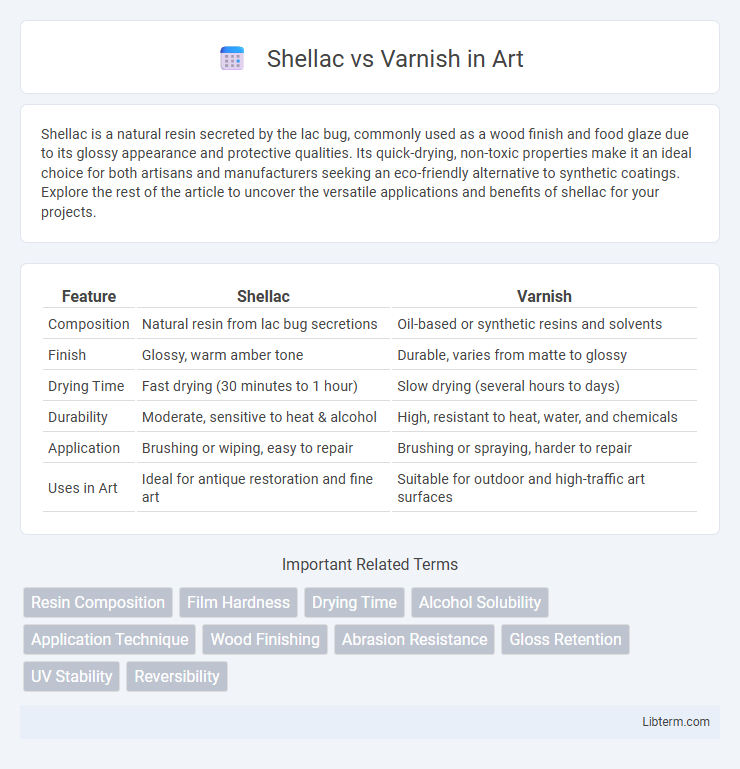Shellac is a natural resin secreted by the lac bug, commonly used as a wood finish and food glaze due to its glossy appearance and protective qualities. Its quick-drying, non-toxic properties make it an ideal choice for both artisans and manufacturers seeking an eco-friendly alternative to synthetic coatings. Explore the rest of the article to uncover the versatile applications and benefits of shellac for your projects.
Table of Comparison
| Feature | Shellac | Varnish |
|---|---|---|
| Composition | Natural resin from lac bug secretions | Oil-based or synthetic resins and solvents |
| Finish | Glossy, warm amber tone | Durable, varies from matte to glossy |
| Drying Time | Fast drying (30 minutes to 1 hour) | Slow drying (several hours to days) |
| Durability | Moderate, sensitive to heat & alcohol | High, resistant to heat, water, and chemicals |
| Application | Brushing or wiping, easy to repair | Brushing or spraying, harder to repair |
| Uses in Art | Ideal for antique restoration and fine art | Suitable for outdoor and high-traffic art surfaces |
Introduction to Shellac and Varnish
Shellac is a natural resin secreted by the lac bug, dissolved in alcohol to create a fast-drying finish commonly used for wood sealing and enhancing grain appearance. Varnish, a synthetic or natural oil-based finish, provides a durable, protective coating that is resistant to heat, chemicals, and UV light, ideal for both indoor and outdoor wood surfaces. Both finishes serve distinct purposes in wood finishing, with shellac prized for its ease of application and warm gloss, while varnish is valued for its superior durability and water resistance.
Composition and Ingredients
Shellac is a natural resin secreted by the lac bug and dissolved in alcohol, primarily composed of esters of aleuritic acid, which provides a glossy, protective finish. Varnish is a synthetic or natural resin-based coating made from drying oils, resins, and solvents, designed for durability and water resistance. The key difference lies in shellac's organic, alcohol-soluble composition versus varnish's often oil-based, chemically cured formulation.
Application Methods
Shellac is typically applied using a brush or a lint-free cloth in thin, even coats that dry quickly, allowing for multiple layers in a short period. Varnish requires careful brushing with high-quality synthetic or natural bristle brushes to avoid bubbles and runs, often needing longer drying times between coats. Both finishes benefit from sanding between layers to enhance adhesion and achieve a smooth, durable surface.
Drying and Curing Times
Shellac typically dries within 30 minutes to an hour, allowing for quick recoating and faster project completion, while varnish can take several hours to dry and up to 24-48 hours to fully cure. Shellac's rapid drying time is due to its alcohol base, which evaporates quickly, whereas varnish, composed of oils and resins, requires longer curing to achieve full hardness and durability. Understanding these differences helps in selecting the appropriate finish for time-sensitive woodworking or protective coating needs.
Durability and Protection
Shellac offers moderate durability and provides a natural, warm finish but is less resistant to heat, water, and alcohol compared to varnish. Varnish creates a hard, protective coating that excels in durability and resists scratches, chemicals, and weathering, making it ideal for high-traffic surfaces and outdoor use. For long-lasting protection, varnish outperforms shellac in maintaining surface integrity under heavy wear and environmental exposure.
Appearance and Finish
Shellac provides a warm, amber-toned finish with a natural gloss that enriches the wood's grain, creating a smooth and polished surface. Varnish offers a more durable, glossy or satin finish that enhances color depth while providing greater resistance to scratches, heat, and moisture. The choice between shellac and varnish depends on the desired aesthetic effect and the level of protection needed for the wood surface.
Suitability for Different Woods
Shellac is highly suitable for softwoods like pine and cedar, as it enhances their natural grain without masking their lighter tones, while offering a warm, amber finish. Varnish is better suited for hardwoods such as oak, maple, and mahogany due to its durability and ability to provide a tough, protective layer against scratches and moisture. The choice between shellac and varnish depends on wood type, desired finish clarity, and the level of protection required for the project.
Maintenance and Repair
Shellac requires frequent maintenance due to its lower resistance to moisture and heat, necessitating regular reapplication to maintain its protective qualities. Repairs to shellac finishes are simplified by its ability to be easily dissolved with alcohol, allowing seamless blending without stripping the entire surface. Varnish offers greater durability and resistance to wear, requiring less frequent upkeep but demanding more extensive sanding and refinishing during repairs to restore damaged areas.
Environmental and Health Considerations
Shellac is a natural resin derived from lac bugs, making it biodegradable and non-toxic, which is safer for indoor air quality and human health. Varnish typically contains synthetic chemicals and solvents that emit volatile organic compounds (VOCs), contributing to environmental pollution and respiratory irritation. Choosing shellac reduces harmful chemical exposure and environmental impact compared to traditional varnishes.
Cost and Availability
Shellac is generally more affordable and widely available in hardware stores, making it a cost-effective choice for many woodworking projects. Varnish tends to be pricier due to its durability and longer-lasting finish, though it is also readily accessible in most professional and consumer markets. Both products offer various formulations, but shellac's natural resin base typically drives lower costs compared to the synthetic components in varnish.
Shellac Infographic

 libterm.com
libterm.com